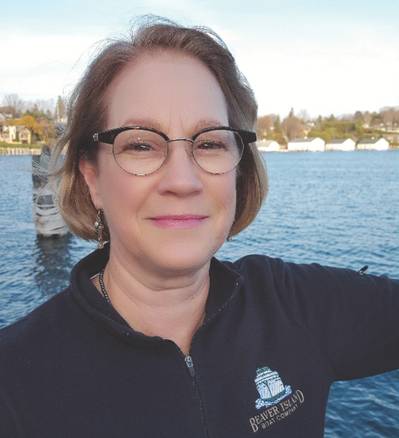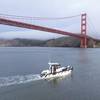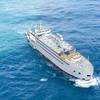Margo S. Marks is President/General Manager of Beaver Island Boat Company, Beaver Island, Mich. The company has provided passenger, vehicle and freight services, between Beaver Island and Charlevoix, Mich. since 1984. The first ferry service to the island began in 1890. B.I. Boat Company operates two subchapter K vessels with a capacity of up to 294 passengers and 16 vehicles on the larger vessel, and 172 passengers and 9 vehicles on the smaller vessel. Notably, Margo has deep roots in the Gresat Lakes community and graduated from the Great Lakes Maritime Academy in 1983, She holds a First Class Pilot (Great Lakes) and Mates Great Lakes/Inland Water license of any gross tons and a 100 ton Masters license. Beyond this, she also graduated from Ferris State University where she earned her BA in Business Administration in 1984. Margo has been with Beaver Island Boat Company since 2001 and currently serves as PVA’s President, having previously served for 6 years on the board of directors. She is the former Chairman of the PVA Regulatory Committee and participates in the Quality Partnership meetings with the U.S. Coast Guard. A strong industry leader and a recognized stakeholder in many aspects of advocacy and outreach, she also serves on the U.S. Coast Guard’s Western Michigan Area Maritime Security Committee, the safety committee for the Inland Seas Education Association, and is a member of the Great Lakes Captains Association and the International Shipmasters Association Lodge 23. To say that she has her finger on what is important to ferry operators on the Great Lakes – and everywhere else – would not be overstating the case. Listen this month as she weighs in on the important issues and challenges facing North America’s passenger vessel and ferry industries.
As President of PVA, where can you do the most good for the organization and its members?
As PVA President, I am responsible for setting the strategic direction for our association. Working with my fellow Officers, Board of Directors and PVA staff we identify both long and short-term work priorities and issues that are important to our diverse membership. As the voice of the U.S. passenger vessel industry, advancing the economic health of our industry, while promoting safety and a secure maritime operating environment nationwide are key elements to our mission. I’ve drawn upon my years of experience in the passenger vessel industry to assist in achieving our goals. PVA speaks directly with lawmakers and regulators to advocate for the industry. One of my major initiatives this year was to expand our partnership work with the Coast Guard. We’ve done this by increasing our participation in Coast Guard Industry Day events across the country, and initiating new working groups to develop voluntary guidelines to reduce slips, trips and falls, clarifying and updating Coast Guard policy and guidance on engine control system automation and identifying ways to increase Coast Guard enforcement of illegal charter operations nationwide. This important work enhances our relationship with Coast Guard leadership and promotes greater understanding, which helps improve member interactions with the Coast Guard.
Under your leadership, what are some of the activities that PVA has engaged in to advance the industry?
As my presidency began earlier this year, President Obama signed into law superseding amendments to the ‘one-size-fits-all’ survival craft law. This fulfills PVA’s long-sought goal of continuing to have the Coast Guard establish survival craft rules based on risk analysis. I’d like to take credit, but the heavy lifting to achieve this accomplishment took place under the watch of my predecessor Dave Anderson and earlier PVA Presidents. PVA has been involved in the TWIC Reader rulemaking process since 2006. In the final rule, the Coast Guard used risk-based analysis for determining which vessels needed readers, essentially exempting all U.S. flagged-passenger vessels. We are delighted that the Coast Guard has supported PVA’s long-held position that TWIC Readers are unnecessary for the vast majority of passenger vessel operators. We strongly believe that current industry security measures are effective in protecting passengers and crew and we are pleased that the Coast Guard has agreed with us. PVA has also developed a new online training portal for members. PVA’s safety and security training resources are now more accessible than ever. The data collected from users of this program will be helpful in developing additional training tools for the future. Additionally, PVA worked with the Coast Guard to obtain a blanket waiver from new Federal Communications Commission rules requiring upgraded radio systems. These new devices would have been much more expensive and overly complex than what is needed for domestic passenger vessels. We can continue to use a radio system that is more appropriate for our industry’s needs.
What is the PVA Alternate Security Program, what is its purpose?
PVA’s Alternate Security Program (ASP) provides a comprehensive framework for security procedures while at the same time allowing companies the flexibility to address the unique features of their operations and make the Program their own. PVA’s ASP is a Coast Guard approved program to help members meet their security requirements. Passenger vessel operators have basically two choices for compliance with the Maritime Transportation Security Act. One option is for a company to write and implement an individual security program that must be approved by the Coast Guard. The other is to use the PVA ASP, which is a Coast Guard-approved alternative that can be easily implemented. PVA consistently works with the Coast Guard to ensure that the ASP is updated to include any federal security policy changes. A forthcoming revision will incorporate the new Transportation Worker Identification Credential (TWIC) Reader requirements for certain facilities and will provide guidance on assessing cyber security risks. We continue to encourage security awareness and training. Our Safety and Security Committee has developed a series of templates to assist with security drills and exercises.
PVA members also have participated in a number of Active Shooter exercises in coordination with various law enforcement and federal agencies. The follow-up reports highlight lessons learned and recommendations for member use.
What’s the biggest regulatory headache on the table right now for PVA member companies? Why? And, what can be done about it?
PVA is concerned about the possibility of strained Coast Guard inspection resources as a result of new Coast Guard responsibilities, including the promulgation of the Subchapter M rule, which has added new inspection duties without increasing resources. PVA has expressed its concern to the Coast Guard about this and is working closely with them to develop new risk-based approaches to vessel inspections which will improve and simplify the inspection process for both passenger vessel operators and Coast Guard inspectors. At the same time, PVA continues to communicate with Congress about the ongoing need to adequately fund the Coast Guard marine safety mission.
Arguably, the most frustrating aspects of the Coast Guard’s casualty investigation and reporting processes are its perceived inconsistent application, inappropriate restriction of operations and an outdated reporting form. Has there been any progress in the past 12 months on this front?
PVA has consistently sought improvement in the casualty reporting process. Members consistently reported confusion about what and when to report because of inconsistency from port-to-port and from investigator-to-investigator. Confusion, over-reporting, misinterpretation of regulation and policy and Coast Guard overreaction were seen as symptoms that required a new approach, which resulted in the new Navigation and Vessel Inspection Circular (NVIC) issued in July, 2015. The NVIC clarified Injury reporting on natural or pre-existing medical conditions in passenger injury and death; reporting of bump and go groundings; and loss of vessel systems without loss of maneuverability—all not requiring the submission of CG Form 2692. Overall, we feel that the Coast Guard requirement for immediate reports of a possible marine casualty is greatly improved with qualified marine investigators making decisions about submitting a CG Form 2692. While there have been needed improvements in the marine casualty reporting process, we still feel that the dollar threshold for marine casualty reporting remains unrealistically low. PVA is advocating for an increase in this dollar amount that is more in line with today’s costs and accounts for inflation. This has to be accomplished by a regulatory change.
If you had to choose just one issue that is facing PVA members that you deem the most important to address in the coming year, then what would that be, and why?
PVA is aggressively working to combat illegal charters that are marketed via the Internet. Nationwide, we’ve seen an increase in operators promoting the sale of charters for hire that do not meet the regulatory requirements for safety, inspection, and licensing. Many of these are being marketed wide-spread to the public through various boat-sharing websites. The public should be made aware of the hazards associated with taking trips on vessels not subject to the same level of safety regulations and oversight as inspected passenger vessels. PVA is encouraging the Coast Guard to augment their investigation and enforcement in this area and has additionally established an official chartered working group with the Coast Guard to address this issue. The Coast Guard needs to reach out to these organizations and clarify the legal requirements associated with chartering a recreational vessel.
Are there any other regulatory changes looming for the industry that gives you and your collective membership particular concern? If so, which ones and in what ways do the new rules impact operations?
At the end of 2017 thousands of smaller commercial vessels will be subject to the Environmental Protection Agency’s Vessel General Permit (VGP) for incidental wastewater discharges. For years, commercial vessels less than 79 feet in length (with no ballast water) were statutorily exempt from this permit. This exemption is based on an earlier EPA report to Congress that showed such discharges from “smaller” vessels have minimal impact. Without Congressional action, thousands of smaller passenger vessels and commercial charter fishing vessels across the country will become subject to additional but unnecessary federal regulation. To this end, PVA has been working with a coalition of maritime industry groups in support of the Vessel Incidental Discharges Act (VIDA) (H.R. 980/S.373). VIDA will make this exemption permanent, and will streamline a number of challenges facing operators of vessel who are subject to the VGP. We hope to see Congress take action to resolve this issue.
(As published in the January 2017 edition of
Marine News)











